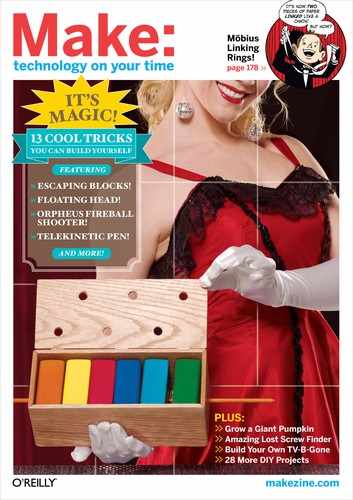PROTO
Making Magic
Illusion designer John Gaughan is the man behind the curtain.
ARTHUR C. CLARKE FAMOUSLY SAID, “ANY sufficiently advanced technology is indistinguishable from magic.” In response, modern conjurers like to say, “Any sufficiently advanced magic is indistinguishable from technology.” At the intersection of both maxims sits John Gaughan.
For five decades, he’s designed and built illusions for everyone from Doug Henning to Siegfried and Roy. Ever seen David Copperfield fly? Gaughan gave him those invisible wings. Scratched your head as David Blaine makes a person’s watch disappear and rematerialize behind a shop window across the street? Gaughan’s handiwork in action.
Gaughan makes the magic behind the magician.
“I’m fascinated with how primitive the human mind still is,” he says. “It can be misdirected so easily.”
Gaughan’s Los Angeles workshop more closely resembles a theatrical scene shop than a master craftsman’s studio. Large props lean against the walls, hand tools are scattered on tables, one assistant cuts lumber outside the shop’s garage door while another paints a classic Oriental motif on a large wooden box.
Look closely, though, and you begin to get a feel for the real magic of the place. Two elderly parrots roost overhead. A clarinet-playing robot stands frozen inside a glass display case. Off to one side, an android in a turban awaits the next move in a game of chess.
Their stories Gaughan is happy to tell. However, the various other illusions under construction aren’t part of the tour. The maker behind the magic does not intend to reveal his secrets, or those of his clients.
Like many kids, Gaughan was first enchanted with magic as a young boy hanging around a magic shop in his hometown of Dallas. When he was 14, a local magician, Mark Wilson, hired the enthusiastic teen as his gofer and handyman. At 21, Gaughan followed Wilson to Los Angeles in 1960 to work on his national television series The Magic Land of Allakazam. Later he studied industrial and furniture design at California State University, Los Angeles, and went on to teach at CSU Northridge with famed designers Gerald McCabe and Sam Maloof. The fine craftsmanship he learned designing furniture translates directly into his work for the stage. His magic wand is a screwdriver.
“I like working with my hands,” Gaughan says. “And I always liked magic. If you have an interest in something, you can usually find a way to learn to do it yourself.”
A legend in magic circles, Gaughan has become the go-to maker for magicians in search of a new spectacle. He has an arsenal of ingenious mechanisms to vanish people, levitate them, and subject them to multiple swords thrust through the body.
“There are some common illusions we build that may be ho-hum to the audience, but I’ve enjoyed working on every mechanism,” Gaughan says.
Many of Gaughan’s best-known gimmicks are modeled on classic illusions from a century ago, or before. For example, in the late Doug Henning’s 1980s Broadway show, the hippie magician hugs a young woman who then vanishes right before the audience’s eyes. That was based on a 19th-century illusion that Gaughan had to reverse-engineer just by reading old articles about it. Other illusions, like Blaine’s mind-blowing street magic routines, are fresh off the drawing board, or rather the workbench.
“We don’t do any design work on a computer,” Gaughan explains. “We start full-scale so you can walk around the object and see it like the audience would. That’s hard to do with CAD, so we prototype with duct tape and cardboard. Then we start cutting wood.”
Not only are magicians always looking for bigger and better illusions, Gaughan’s ingenuity is also sought out by Broadway directors and rock stars. He’s old pals with Alice Cooper, created stage effects for Ozzy Osbourne and The Doors, and most recently delivered levitations and vanishings for the forthcoming musical Merry-Go-Round, composed by the Sherman Brothers, who previously wrote the songs for Walt Disney’s Mary Poppins.
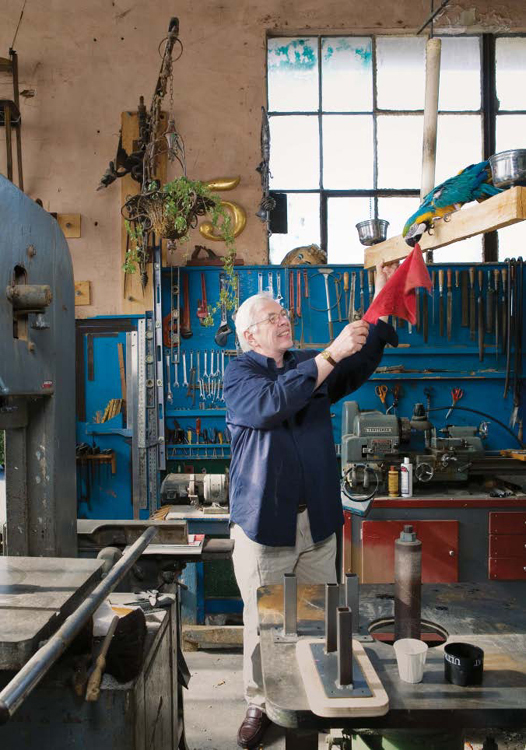
LEGEND OF LEGERDEMAIN: John Gaughan plays with Luther, one of his two parrots. Luther, 45, is a former circus performer from Argentina. Luther’s companion, Max, is 85 years old. Gaughan says that when he’s in the next room, he often overhears Luther and Max talking to each other.

“We turn away much more work than we take in,” Gaughan says. Hours to spare are essential, he says, so that he has ample time to make magic for himself. That means restoring and re-creating the wonder of magic history. In the dusty storage space and office behind Gaughan’s shop lies his own incredible museum of illusions past. A glass showcase filled with exquisitely crafted “ball and vase” tricks from a century ago sits near stacks of magic boxes, collapsible metal urns, tables with secret storage compartments, and piles of unidentifiable mechanisms from long-lost illusions.
“I like looking at these mechanisms and asking what the maker could possibly have been thinking,” Gaughan says. “I can usually figure out what something does, but why it does it — what the illusion was that required the mechanism — is often a mystery.”
Not far away from a display of original Houdini handcuffs is Houdini himself, or rather a life-size animatronic model of the famed magician sitting in a re-creation of his study from 1922. Press the button and the Houdini robot signs an autograph. “It’s very close to his real handwriting too,” Gaughan proudly points out.

Every surface, every shelf, in these cramped quarters is packed with apparatuses and ephemera that once delighted audiences. It’s a cabinet of curiosities that even P.T. Barnum would line up to see.
In fact, if Barnum were alive, he’d be thrilled to encounter the Android Clarinetist in Gaughan’s shop. Built in Holland in 1838, it was bought by Barnum for his own museum, which eventually burned to the ground. The Clarinetist made its way to a University of Michigan warehouse where it sat in disrepair for 100 years until Gaughan got wind of it.
“It was a wonderful mechanism but it was so rusty and broken that it looked like it came off the Titanic,” Gaughan says.
Several years of maker surgery brought the Clarinetist back to life. Its new owner is quick to point out that this is no music box stuffed inside a mannequin. The fingers are articulated, enabling it to actually play Beethoven and Weber compositions on its custom instrument.
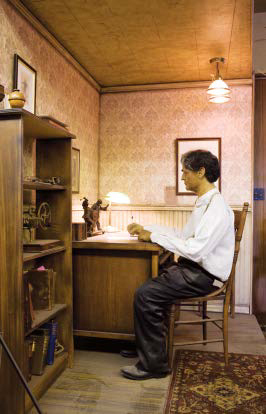
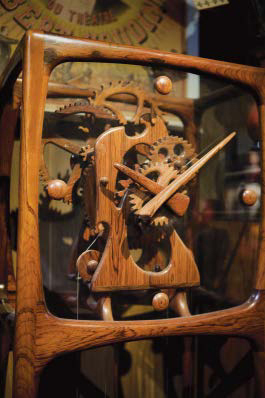
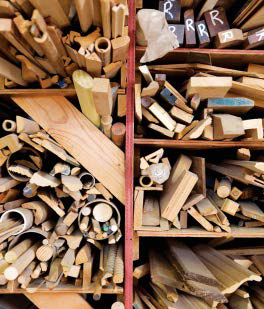
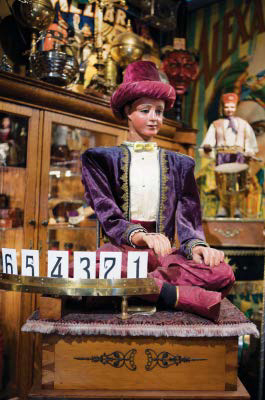
OPPOSITE: One of Gaughan’s many display cases packed with 18th- and 19th-century magic apparatuses. Inset shows 19th-century French boxwood ball-and-vase tricks. THIS PAGE, CLOCKWISE: The Harry Houdini automaton in a re-creation of his 1922 office; dowels of every size; Psycho, an 1875 automaton formerly owned by Harry Kellar and Houdini; one of 12 clocks built by Gaughan entirely from Brazilian rosewood.
“I’m fascinated with how primitive the human mind still is. It can be misdirected so easily.”
The Android Clarinetist was the poster child for a massive 2001 exhibition at the Getty Center titled Devices of Wonder. Gaughan appreciated the opportunity to introduce the public to several of his own wonderful devices, including a re-creation of a famous robot named The Turk, who played chess against the likes of Napoleon Bonaparte and Ben Franklin and was written up by Edgar Allan Poe.
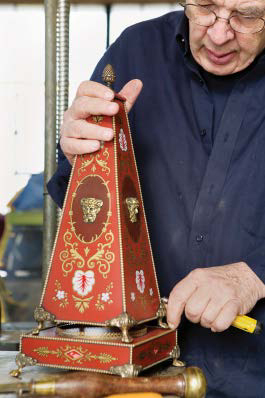
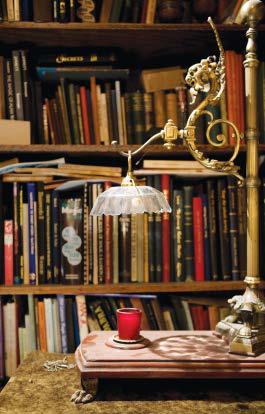
The Turk was built in 1770 by Hungarian inventor Wolfgang von Kempelen. Then the world’s most advanced automaton, The Turk drew huge crowds as it toured Europe and America. To satisfy doubting Thomases, von Kempelen would open the machine to reveal a system of gears and levers resembling a wristwatch’s grand complication. Of course, The Turk turned out to be a hoax anyway: a human chess master hid inside the cabinet. In 1854, The Turk was destroyed in a fire and instantly became the stuff of legend. A century later, engravings of the machine reprinted in magic magazines caught Gaughan’s attention.
“I kept asking myself how they hid a full-size person in there with all the gears and levers?” Gaughan recalls. “So I decided to rebuild it.”
Twenty years, three prototypes, and more than a few dollars later, Gaughan’s Turk is a near-perfect re-creation of von Kempelen’s. He even replicated the original Turk’s chessboard that wasn’t caught in the blaze. The reborn Turk is a marvel to behold, but even a close examination begs the question that captured Gaughan’s imagination: how does a person fit inside the box with all the mechanics? When asked, Gaughan doesn’t miss a beat.
“You’ve got to keep some of the magic alive,” he says with a wry smile.
MAKE Editor-at-large David Pescovitz is co-editor of boingboing.net and a research director at Institute for the Future.
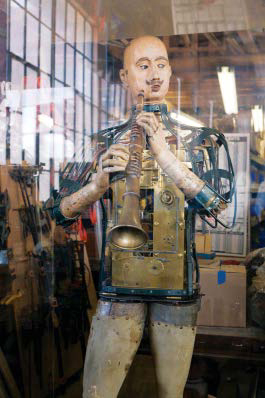
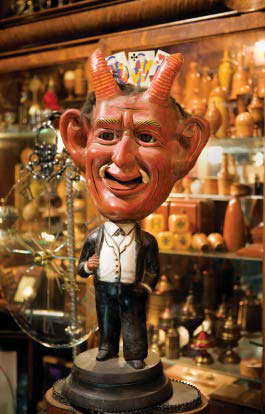
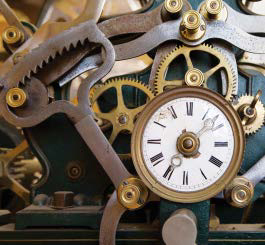
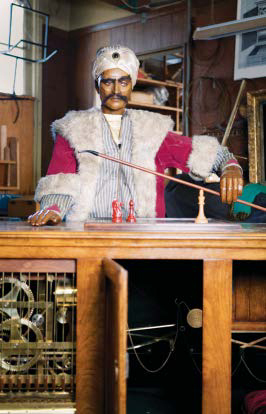
OPPOSITE: Gaughan shows his replica of an 1830s French illusion where water was transformed into wine. A fortunetelling bell from the same period was secretly triggered with electricity, itself a “magical” phenomenon at the time. THIS PAGE, CLOCKWISE: Android clarinetist plays a 32-note scale; Gaughan restored this massive clock mechanism from a French cathedral; The Turk awaits its next chess opponent; at a magician’s command, this little devil would produce cards, rings, and keys vanished from the audience.
